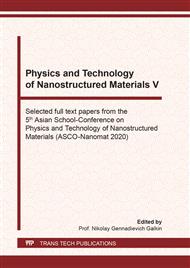[1]
S.C. Singh, Zinc oxide nanostructures: synthesis, characterizations and device applications, J. Nanoengineering and Nanomanufacturing. 3 (2013) 1-28.
Google Scholar
[2]
S.G. Kumar, K.S.R. Koteswara, Zinc oxide based photocatalysis: tailoring surface-bulk structure and related interfacial charge carrier dynamics for better environmental applications, RSC Adv. 5 (2015) 3306–3351.
DOI: 10.1039/c4ra13299h
Google Scholar
[3]
N. Kiomarsipour, R.S. Razavia, K. Ghani, Improvement of spacecraft white thermal control coatings using the new synthesized Zn-MCM-41 pigment, Dyes and Pigments. 96 (2013) 403–406.
DOI: 10.1016/j.dyepig.2012.08.019
Google Scholar
[4]
S. Agostinelli, J. Allison, K. Amak, J. Apostolakis et al., Geant4 - a simulation toolkit, Nuclear Instruments and Methods in Physics Research Section A. 3 (2003) 250-303.
Google Scholar
[5]
V.V. Neshchimenko, C.D. Li, M.M. Mikhailov, А.N. Dudin, Effect of the Surface Morphology of Zinc Oxide Particles on their Radiation Stability, Physics and Technology of Nanostructured Materials IV. 1 (2018) 338-342.
DOI: 10.4028/www.scientific.net/ddf.386.338
Google Scholar
[6]
V.V. Abraimov, A.A. Negoda, A.P. Zavalishin, L.K. Kolybaev, Complex imitation of space factors, Space Science and Technology. 1. (1995) 76-80.
DOI: 10.15407/knit1995.02.076
Google Scholar
[7]
D.L. Dexter, Absorption of light by atoms in solids, Phys. Rev. 101B (1956) 48-55.
Google Scholar
[8]
A.S. Davydov, Quantum mechanics, third ed., Science, Moscow, (2014).
Google Scholar
[9]
C. Leroy, P. Rancoita, Principles of Radiation Interaction in Matter and Detection, fourth ed., World scientific publishing, New Jersey, (2016).
Google Scholar
[10]
M. Kahoulia, A. Barhoumia, A. Bouzida et al., Structural and optical properties of ZnO nanoparticles prepared by direct precipitation method, Superlattices and Microstructures. 85 (2015) 7-23.
DOI: 10.1016/j.spmi.2015.05.007
Google Scholar


